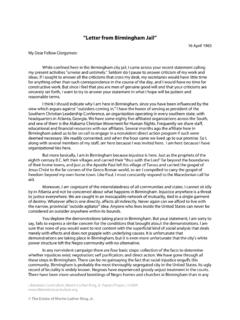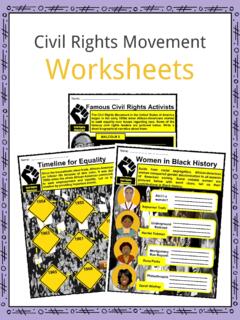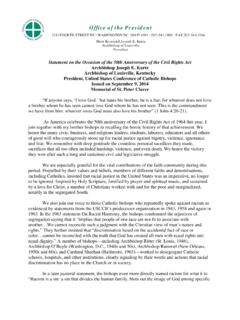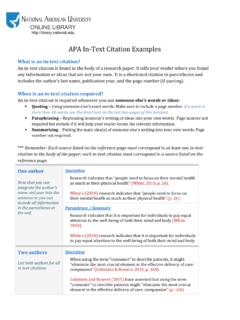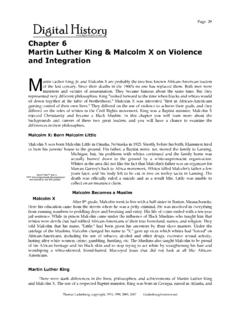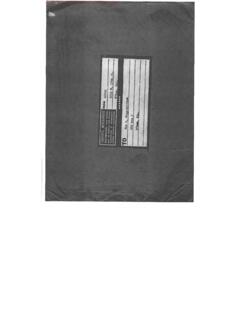Transcription of The Civil Rights Movement: Timeline 1954-1968
1 The Civil Rights Movement: Timeline 1954-1968 1954: Brown v. Board of EducationThis decision, handed down by the Supreme Court of the United States, has been described as the moment that launched the modern Civil Rights movement. Following years of protest, led initially by black students and their parents at Molton High School in Virginia, the National Association for the Advancement of Colored People (NAACP), made five cases challenging the school system. These cases were later combined under what is known as Brown v. Board of Education. The drive to end segregation in schools across the USA and put African-American and white children in the same classroom was based on a belief that the dominant group would keep control of the most successful schools and that the only way to get a full range of opportunities for a minority child was to get access to those schools , according to Gary Orfield when co-director at the Harvard Civil Rights Project.
2 1955: The Montgomery Bus Boycott On 1st December 1955, Rosa Parks was arrested for refusing to give up her seat on a public bus in Montgomery, Alabama. Parks was tried and convicted for disorderly conduct and violating a local ordinance . The Women s Political Council (WPC), alongside other leaders in the black community, seized on this moment and launched a full-blown citywide boycott of the buses. During the early days of the boycott, the WPC urged those involved in the boycott to attend a mass meeting at Dexter Avenue Baptist Church to hear the words of Reverend Martin luther king , Jr. He was recruited as spokesman for the Montgomery Bus Boycott. The boycott lasted for over a year with the support of most of Montgomery s 50,000 African-Americans, many of whom had to walk several miles to work each day.
3 In November 1956, a federal court ordered that Montgomery s buses be desegregated and the boycott stopped its goal achieved. 1957: The Campaign of Massive Resistance to school desegregation Arkansas Governor, Orval Faubus, ordered his state s national guard to bar entry to nine African-American students to Little Rock s Central High School. The nearly month-long confrontation ended when President Eisenhower sent in US troops to protect the students. These and other tactics were used to prevent African-American students attending integrated schools by 1964 only of African-American children in the Deep South attended integrated schools. Page 1/51957: Martin luther king Jr. elected as president of Southern Christian Leadership ConferenceThe Southern Christian Leadership Conference (SCLC) was an organisation designed to provide new leadership for the burgeoning Civil Rights movement, bringing together the churches, students and other nonviolent activist Civil Rights groups in the South.
4 Martin luther king Jr. would lead this organisation until his assassination in : The year of sit-insAlthough sit-ins were not a new technique, having been used since the late 1930s in the movement for Civil Rights , in 1958, they proved a successful tool in many instances from the sit-ins at the lunch counter of the Dockum Drug Store in Wichita, Kansas which got the store to change its policy of segregated seating. Sit-ins took place not only on lunch counters but also on parks, beaches, libraries, theatres, museums, and other public facilities. 1960: Television as a catalyst for changeBy 1960, ninety percent of American homes had a television. Television became a catalyst for change on a massive scale.
5 People could now see what was happening all over the country: in Selma, birmingham , and Memphis. Not only did television inform the public about the burgeoning Civil Rights movement, it also helped to unify the movement itself. Local struggles became seen in a national context as those across the United States gained access to national newscasts that were witnessing and documenting this revolution. 1960: Greensboro Sit-in The Greensboro sit-in was a defining action against racial segragation practiced by the private-sector in the 1960s. Initiated by four African-American students the planned sit-in took place on 1st of February 1960 at the lunch counter reserved for whites only in the Woolworths store in Greensboro, North Carolina.
6 The Greensboro 4, as they were later called, left the store after being refused service and at the request of the store manager. Over the following months dozens then hundreds of students went to the store and requested service, when refused they remained in their seats or were replaced by other students, black and white, who had been waiting in line outside the shop. Student led sit-ins spread across the town and the South. Within 6 months many stores faced with significant reductions in turnover either desegragated their lunch counters or closed them altogether to avoid problems. The significance of the impact of youth organised and led protests was not lost on the leadership of the main Civil Rights organisations and Martin luther king expressed pride in their non-violent 2/51961: Freedom Rides Freedom Rides were journeys made by Civil Rights activists to the Southern States of the USA.
7 These journeys were made to test a Supreme Court decision, Boynton v. Virginia (1960), which ruled that segregation was unconstitutional on interstate travel. The first Freedom Ride, organised by the Congress of Racial Equality (CORE), left Washington DC on May 4th 1961. Both this and subsequent Freedom Rides proved to be dangerous for those involved one bus was firebombed, one group of riders attacked by the Ku Klux Klan and many by mobs in the cities they travelled to. On May 24th 300 riders to Jackson Mississippi were arrested and put in jail . 1961: Interstate Commerce CommissionOn November 1st 1961, the Interstate Commerce Commission which had been created by John F. Kennedy s administration, issued a desegregation order.
8 This enabled passengers to sit wherever they chose on buses, white and colored signs came down in the terminals; separated drinking fountains, toilets, and waiting rooms were consolidated; and restaurats and cafes in bus stations began serving people regardless of skin colour. 1963: March on Washington In August 1963, a quarter of a million people marched down the National Mall in Washington DC calling for jobs and freedom . The march actually had six official goals: calling for meaningful Civil Rights law; a massive federal works program; full and fair employment; decent housing; the right to vote; and adequate integrated education. It was at this march that Martin luther king Jr. delivered his famous I Have a Dream speech a speech in which he set forth his vision for the society he hoped for for his children.
9 Later in 1963 he was named Time magazine s Man of the Year. And the following year, he received the Nobel Peace Prize. 1963: The Letter from birmingham JailDuring 1963, Martin luther king Jr. led a coalition of Civil Rights groups aimed at birmingham Alamaba. At that time, this city was described as the most segregated in America. The police violence against these nonviolent protestors was vividly displayed on the televisions of the nation leading to widespread public outrage and ultimately unprecedented Civil Rights legislation. It was during this campaign that Martin luther king Jr. drafted the Letter from birmingham jail the manifesto of Martin luther king Jr. s philosophy and practice.
10 Page 3/51964: Malcolm X formerly adovocates self-defense and Black nationalismDuring 1963 and 1964, Civil Rights activists became increasingly combative. In spite of the dominant nonviolent tradition in the movement, it was said non-violence won t work in made up our if a white man shoots at a Negro in Mississippi, we will shoot back. In April 1964, Malcolm X gave The Ballot or the Bullet speech an ultimatum to white America that either African-Americans Rights would be recognised and respected or militant activity would be the : Civil Rights Act This Act essentially eliminated legalised racial segregation in the US. The legislation made it illegal to discriminate against blacks or other minorities in hiring, public accommodations, education or transportation.
